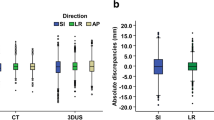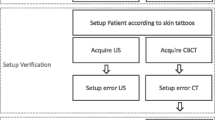Abstract
The purpose of this study is to create a new pseudo-computed tomography (CT) imaging approach under superposed ultrasound (US) deformation fields based on step-by-step local registration. Scanned CT and US 3D image datasets of three patients with postoperative cervical carcinoma were selected, including CT (CTsim) and US images (USsim) acquired during simulated positioning process and cone beam CT (CBCT) and US images for positioning verification (USpv) acquired after treatment for 10 times. Regions of interest such as urinary bladders were segmented out and accepted local registration to obtain different deformation fields. These deformation fields were successively performed according to their order and then applied to localized CT images to obtain pseudo-CT (CTps). After filtering, we obtained the final correct pseudo-CT (CTpsf). The pseudo-CT based on the mask of the whole imaging region of US images (WCTps) were acquired as control. Then, we compared CTpsf, CTps, WCTps, and CBCT in terms of their similarity in anatomical structure and differences in pseudo-CT and CTsim in terms of dosimetry. Structural similarity degree between CTpsf and CBCT was larger compared with that between CTps and WCTps. Target regions and dosages of endangered organs between CTpsf and CTsim were different under the same calculation conditions based on the Monte Carlo algorithm. Compared with the VMAT plan of CTsim, the pass rate of CTpsf in γ analysis under the standards of 2% dosage difference and 2-mm distance difference was 91.8%. The imaging quality of CTpsf was better compared with WCTps and CTps. It exhibited high similarity with CBCT in anatomical structure and had favorable application prospect in adaptive radiotherapy.

The local deformation registration is performed between the ultrasound images based on different regions of interest, and then stepwise applied to localized CT images to obtain pseudo-CT. After filtering, the corrected pseudo CT image is obtained.






Similar content being viewed by others
Explore related subjects
Discover the latest articles, news and stories from top researchers in related subjects.References
Takemura A, Shoji S, Ueda S, Kurata Y, Kumano T, Takamatsu S, Suzuki M (2009) Effect of daily setup errors on individual dose distribution in conventional radiotherapy: an initial study[J]. Radiol Phys Technol. 2(2):151–158
Yan D, Ziaja E, Jaffray D, Wong J, Brabbins D, Vicini F, Martinez A (1998) The use of adaptive radiation therapy to reduce setup error: a prospective clinical study[J]. Int J Radiat Oncol Biol Phys 41(3):715–720
Yan H, Zhen X, Cerviño L, Jiang SB, Jia X (2013) Progressive cone beam CT dose control in image-guided radiation therapy[J]. Med Phys 40(6):060701
Meroni S, Mongioj V, Giandini T, Bonfantini F, Cavallo A, Carrara M, Stucchi C, Cavatorta C, Pignoli E (2016) EP-1822: limits and potentialities of the use of CBCT for dose calculation in adaptive radiotherapy[J]. Radiother Oncol 119:S854–S855
Pennec X, Cachier P, Ayache N (2001) Tracking brain deformations in time-sequences of 3D US images[J]. 24(4–5):801–813
Andreasen D, Edmund JM, Zografos V et al (2016) Computed tomography synthesis from magnetic resonance images in the pelvis using multiple random forests and auto-context features[C]//SPIE medical imaging. International Society for Optics and Photonics 9784:978417
Cao X, Yang J, Gao Y, Guo Y, Wu G, Shen D (2017) Dual-core steered non-rigid registration for multi-modal images via bi-directional image synthesis[J]. Med Image Anal 41:18–31
Li M, Ballhausen H, Hegemann NS, Ganswindt U, Manapov F, Tritschler S, Roosen A, Gratzke C, Reiner M, Belka C (2015) A comparative assessment of prostate positioning guided by three-dimensional ultrasound and cone beam CT[J]. Radiat Oncol 10(1):82–83
Van d MS, Camps SM, van Elmpt WJ et al (2016) Simulation of pseudo-CT images based on deformable image registration of ultrasound images: a proof of concept for transabdominal ultrasound imaging of the prostate during radiotherapy.[J]. Med Phys 43(4):1913–1920
Camps S, Meer SVD, Verhaegen F, et al. (2016) Various approaches for pseudo-CT scan creation based on ultrasound to ultrasound deformable image registration between different treatment time points for radiotherapy treatment plan adaptation in prostate cancer patients[J]. 2(3):035018
Shrimali V, Anand RS, Kumar V (2009) Current trends in segmentation of medical ultrasound B-mode images: a review[J]. IETE Tech Rev 26(1):8–17
Klein S, Staring M, Murphy K, Viergever MA, Pluim J (2010) Elastix: a toolbox for intensity-based medical image registration[J]. IEEE Trans Med Imaging 29(1):196–204
Shamonin DP, Bron EE, Lelieveldt BPF et al (2013) Fast parallel image registration on CPU and GPU for diagnostic classification of Alzheimer's disease[J]. Front Neuroendocrinol 7(50):50–60
Robinson D, Liu D, Steciw S, Field C, Daly H, Saibishkumar EP, Fallone G, Parliament M, Amanie J (2012) An evaluation of the clarity 3D ultrasound system for prostate localization[J]. J Appl Clin Med Phys 13(4):100–112
Zhang Z, Liu F, Tsui H, Lau Y, Song X (2014) A multiscale adaptive mask method for rigid intraoperative ultrasound and preoperative CT image registration[J]. Med Phys 41(10):102903
Kadir T, Zisserman A, Brady M (2004) An affine invariant salient region detector[C]// Proc European Conference on Computer Vision. 228–241
Lu B, Wang H, Lin Z (2011) High order Gaussian curvature flow for image smoothing[C]// international conference on multimedia technology. IEEE:5888–5891
Vik T, Kabus S, Berg J V, et al. Validation and comparison of registration methods for free-breathing 4D lung CT[J]. Proc Spie, 2008, 6914(6914):69142P-1-69142P-10
Riyahi S, Choi W, Bhooshan N, Tan S, Zhang H, Lu W (2016) Comparison of registration methods for modeling pathologic response of esophageal cancer to chemoradiation therapy[J]. Med Phys 43(6):3331–3339
Dong C, Wang R, Meng X et al (2014) A comparison of liver protection among 3-D conformal radiotherapy, intensity-modulated radiotherapy and RapidArc for hepatocellular carcinoma[J]. Radiat Oncol 9(1):48
Robertson SP, Weiss E, Hugo GD (2012) Localization accuracy from automatic and semi-automatic rigid registration of locally-advanced lung cancer targets during image-guided radiation therapy[J]. Med Phys 39(1):330–341
Geraily G, Mirzapour M, Mahdavi SR et al (2014) Monte Carlo study on beam hardening effect of physical wedges[J]. Iran J Radiat Res 12(3):249–256
Aubry J, Pouliot J, Beaulieu L (2008) Correction of megavoltage cone-beam CT images for dose calculation in the head and neck region[J]. Med Phys 35(3):900–907
Zhang J, Zhang W, Lu J (2015) A correction algorithm for Kilovoltage cone-beam computed tomography dose calculations in cervical Cancer patients[J]. Med Phys 42(6):3242–3242
Funding
This work was supported by the Natural Science Foundation of Jiangsu Province Research of China (grant no. BK20151181).
Author information
Authors and Affiliations
Corresponding author
Ethics declarations
Ethics approval and consent to participate
The protocol of this study was approved by the medical ethics committee of Second People’s Hospital of Changzhou, Nanjing Medical University (2017-002-01).
Competing interests
The authors declare that they have no competing interests.
Consent for publication
Not applicable.
Rights and permissions
About this article
Cite this article
Sun, H., Lin, T., Xie, K. et al. Imaging study of pseudo-CT images of superposed ultrasound deformation fields acquired in radiotherapy based on step-by-step local registration. Med Biol Eng Comput 57, 643–651 (2019). https://doi.org/10.1007/s11517-018-1912-2
Received:
Accepted:
Published:
Issue Date:
DOI: https://doi.org/10.1007/s11517-018-1912-2




